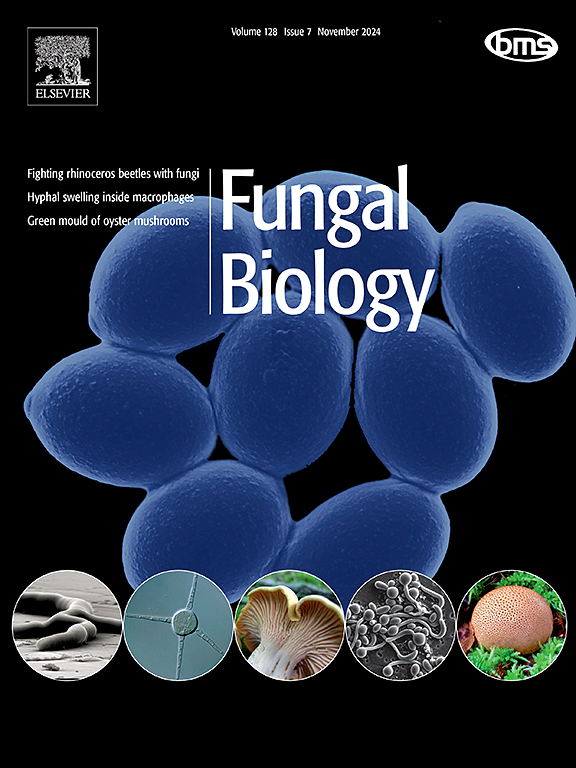木纤维和树皮改性泥炭壳的实时基质势动态及其与双孢蘑菇产量和品质的关系
IF 3
3区 生物学
Q2 MYCOLOGY
引用次数: 0
摘要
对木纤维、未堆肥树皮和窗台堆肥树皮进行了两次重复试验,分别以30%、50%和70% v/v的修正率对商业泥炭基蘑菇外壳进行了测试。将其在作物产量和蘑菇品质方面的表现与行业标准的泥炭基对照进行了比较。在种植过程中,通过使用固态张力计记录基质电位(Ψm),监测套管处理之间的水物理行为(即基质电位)。新生和发育中的蘑菇利用含有外壳的水,导致在“冲洗”期间Ψm减少。不同处理间Ψm进化幅度和持续时间的差异与蘑菇种植性能和品质指标相关。木纤维处理在水分供应和作物种植时间方面与以泥炭为基础的控制密切匹配,Ψm值显示每次冲洗的减少率相似(不超过- 34.4千巴)。从这些处理中得到的A类蘑菇在产量和质量上同样与对照没有区别。相反,基于树皮的套管与基于泥炭的控制处理不同,其时间和水动力学受到套管下入长度等管理条件的强烈影响。在某些情况下,树皮添加率的增加与作物种植的延迟相关(与对照处理相比延迟了4天)。此外,含有处理的树皮相对开放的孔隙结构导致保水能力差,覆盖(在第一次冲洗期间)和随着时间的推移孔隙结构退化,需要仔细的作物管理。在这些套壳处理中(特别是在试验1,冲洗2中),可用水的缺乏不仅证明了水分胁迫蘑菇的发育缓慢(例如过早开放,茎杆分裂),而且还与随着种植的进行而出现的一种停滞或停止Ψm进化模式有关。在这些套壳处理中,水分胁迫最终导致B级蘑菇的相对比例较高。平均两次试验,B类蘑菇分别占未堆肥和堆肥树皮总产量的53%和47%。相比之下,泥炭平均只有24%。为了保持与商业泥炭基套管类似的产量、作物时间和错开,泥炭改性处理必须表现出类似的水物理行为表现,以及在反复冲洗和浇水循环中保持结构的能力。本文证明,传感器监测的Ψm进化与作物生长和进展的实质性变化相一致,因此收获的蘑菇产量也发生了变化。本文章由计算机程序翻译,如有差异,请以英文原文为准。
Real-time matric potential dynamics in peat casings amended with wood fibre and bark, and their relationship to Agaricus bisporus yield and quality
Wood fibre, uncomposted bark and windrow-composted bark were tested in two replicate experiments at amendment rates of 30, 50 and 70 % v/v with commercial peat-based mushroom casing. Their performance in terms of crop yield and mushroom quality was compared to an industry standard peat-based control. Hydro-physical behaviour (i.e. matric potential) between casing treatments was monitored during the crop by recording matric potential (Ψm) using solid-state tensiometers. Emerging and developing mushrooms utilised casing-contained water resulting in decreasing Ψm during a ‘flush’. Differences in the magnitude and duration of Ψm evolution between treatments were correlated to mushroom cropping performance and quality metrics.
Wood fibre treatments closely matched peat-based controls in water availability and crop timing, with Ψm values showing a similar rate of decrease over each flush (not exceeding −34.4 kPa). Class A mushrooms from these treatments were likewise indistinguishable from the controls in yield and quality.
Conversely, bark-based casings diverged from peat-based control treatments with their timing and water dynamics strongly influenced by management conditions such as case-run length. Increasing rates of bark addition in some instances was correlated with incrementally delayed cropping (by as much as 4 days relative to control treatments). Additionally, the comparatively open pore-structure of bark containing treatments resulted in poor water retention, overpinning (during 1st flush) and pore-structure degradation over time, requiring careful crop management. A lack of available water occurred within these casing treatments (particularly in Trial 1, flush 2), was evidenced not only by the slow development of water-stressed mushrooms (e.g. premature opening, split stipes), but was also correlated with a pattern of stalling or halted Ψm evolution, as cropping progressed. Water stress in these casing treatments ultimately led to a higher relative proportion of Class B graded mushrooms. Averaged over two trials, Class B mushrooms constituted 53 % and 47 % of the total yield for uncomposted and composted bark respectively. Comparatively peat averaged just 24 %.
In order to maintain yield, crop timing and stagger similar to that of commercial peat-based casing, peat-amended treatments must demonstrate similar expression of hydro-physical behaviour as well as an ability to retain structure over repeated flushing and watering cycles. Herein, it is demonstrated that sensor-monitored Ψm evolution coincides with substantial variation in the growth and progression of the crop and consequently in the yield of harvested mushrooms.
求助全文
通过发布文献求助,成功后即可免费获取论文全文。
去求助
来源期刊

Fungal biology
MYCOLOGY-
CiteScore
5.80
自引率
4.00%
发文量
80
审稿时长
49 days
期刊介绍:
Fungal Biology publishes original contributions in all fields of basic and applied research involving fungi and fungus-like organisms (including oomycetes and slime moulds). Areas of investigation include biodeterioration, biotechnology, cell and developmental biology, ecology, evolution, genetics, geomycology, medical mycology, mutualistic interactions (including lichens and mycorrhizas), physiology, plant pathology, secondary metabolites, and taxonomy and systematics. Submissions on experimental methods are also welcomed. Priority is given to contributions likely to be of interest to a wide international audience.
 求助内容:
求助内容: 应助结果提醒方式:
应助结果提醒方式:


